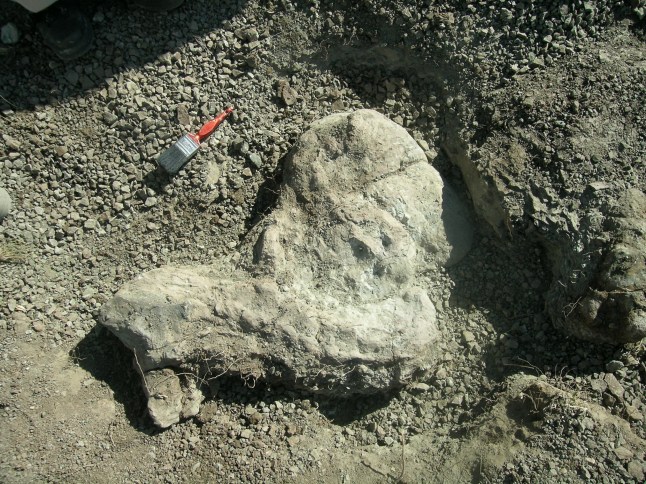
A fearsome sabre-toothed beast the size of a tiger with skin like a rhino was ‘top predator’ in what is now South Africa before going extinct 250million years ago.
The creature called Inostrancevia had trekked 7,000 miles to take control of the territory, reveals new research.
Fossils show a scramble for dominance leading up to ‘the Great Dying’ 252million years ago when Earth experienced a devastating mass extinction, say scientists.
Massive volcanic eruptions triggered catastrophic climate change, killing off nine out of every 10 species and eventually setting the stage for the dinosaurs.
But researchers say that the Great Dying was a ‘long goodbye’ with the extinction event taking place over the course of up to one million years at the end of the Permian period.

And the fossil record shows ‘drama and upheaval’ during that time as species, including Inostrancevia, fought to get a foothold in their changing environments.
A new fossil find suggests that Inostrancevia migrated 7,000 miles across the supercontinent Pangaea, filling a gap in a distant ecosystem that had lost its top predators. before going extinct itself.
Study co-author Dr Pia Viglietti said: ‘All the big top predators in the late Permian in South Africa went extinct well before the end-Permian mass extinction.
‘We learned that this vacancy in the niche was occupied, for a brief period, by Inostrancevia.’
She says it looked the part of ‘top predator.’
Dr Viglietti, a research scientist at the Field Museum in Chicago, said: ‘Inostrancevia was a gorgonopsian, a group of proto-mammals that included the first sabre-toothed predators on the planet.

‘It was about the size of a tiger and likely had skin like an elephant or a rhino; while vaguely reptilian in appearance, it was part of the group of animals that includes modern mammals.’
Inostrancevia had only ever been found in Russia before the new find.
While examining the fossil record of South Africa’s Karoo Basin, Dr Viglietti’s colleague Dr Christian Kammerer identified the fossils of two large predatory animals that were different from those normally found in the region.
Dr Viglietti said: ‘The fossils themselves were quite unexpected.’
She said it’s not clear how they made it from what’s now Russia, or how long it took them to cross Pangaea and arrive in what’s now South Africa.
Dr Viglietti said: ‘When we reviewed the ranges and ages of the other top predators normally found in the area, the rubidgeine gorgonopsians, with these Inostrancevia fossils, we found something quite exciting.
‘The local carnivores actually went extinct quite a bit before even the main extinction that we see in the Karoo – by the time the extinction begins in other animals, they’re gone.’
She says the arrival of Inostrancevia from 7,000 miles away and its subsequent extinction indicates that the top predators were “canaries in the coal mine” for the larger extinction event to come.

Co-author Professor Jennifer Botha, of University of the Witwatersrand, Johannesburg, said: ‘This shows that the South African Karoo Basin continues to produce critical data for understanding the most catastrophic mass extinction in Earth’s history.’
Study first author Dr Kammerer said: ‘We have shown that the shift in which groups of animals occupied apex predator roles occurred four times over less than two million years around the Permian-Triassic mass extinction, which is unprecedented in the history of life on land.
‘This underlines how extreme this crisis was, with even fundamental roles in ecosystems in extreme flux.’
He said the vulnerability of those top predators matches what we see today.
Dr Kammerer added: ‘Apex predators in modern environments tend to show high extinction risk, and tend to be among the first species that are locally extirpated due to human-mediated activities such as hunting or habitat destruction.
‘Think about wolves in Europe or tigers in Asia, species which tend to be slow to reproduce and grow and require large geographic areas to roam and hunt prey, and which are now absent from most of their historic ranges.
‘We should expect that ancient apex predators would have had similar vulnerabilities, and would be among the species that first go extinct during mass extinction events.’
More Trending
As well as shedding fresh light on the extinction event that helped lead to the rise of dinosaurs, Dr Viglietti says that the study, published in the journal Current Biology. can also teach us about the ecological ‘disasters’ the planet is currently experiencing.
She added: ‘It’s always good to get a better understanding of how mass extinction events affect ecosystems, especially because the Permian is basically a parallel on what we’re going through now.
‘We don’t really have any modern analogs of what to expect with the mass extinction happening today, and the Permo-Triassic mass extinction event represents one of the best examples of what we could experience with our climate crisis and extinctions.
‘I guess the only difference is, we know what to do and how to stop it from happening.’
MORE: Scientists discover world’s oldest fossil gnat from 247,000,000 years ago
MORE: 200,000,000-year-old dinosaur fossil found by rescue dog goes on display













